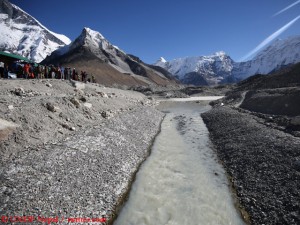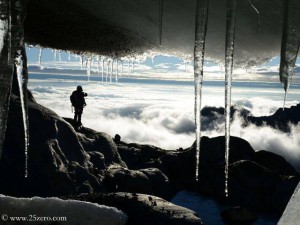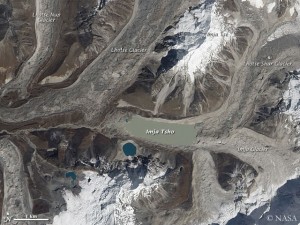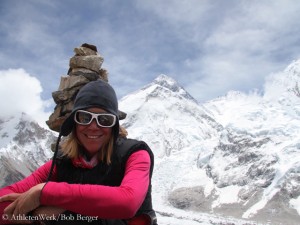Time bomb Imja Tsho defused – for now
It’s like handling a water butt. The amount of rainfall is not manageable. If you want to prevent the butt from overflowing, you must drain the water. According to this model, the water level of Imja Tsho has now been lowered by a total of 3.40 meters over a period of two months. The glacial lake in the Everest region, which is almost 150 meters deep in some places, has steadily expanded over the last few years as a result of climate change, and has become a threat to the downstream villages, especially the nearby located Chukhung and Dingboche. A bursting of the natural dam at an altitude of about 5,000 meters could have devastating consequences. Soldiers from the Nepalese army were involved in the construction work for the canal, via which a total of four billion liters of water were drained. According to the government in Kathmandu, “an estimated 96,562 people, including tourists” – for this exact estimate Nepal earns an entry in the Guinness Book of Records 😉 – are expected to benefit from the project, which cost about three million US dollars and was funded by the United Nations. Daene McKinney, professor of Environmental and Water Resources Engineering at the University of Texas at Austin, was on site and has replied to my questions.
Professor McKinney, you were involved in the Imja Lake lowering project in the Everest region. How dangerous did you assess the situation before starting to drain the water?
![]() read more
read more
If the water towers are empty
It is no more than a coincidence, but a suitable one. This year the “International Mountain Day”, which, since 2002, is observed every year on 11 December, coincides exactly with the final day of the UN Climate Change Conference in Paris – that will end tomorrow hopefully with an agreement on climate protection which is more than just hot air. Mountains are considered as early warning systems for climate change (see the video below). Everyone who is often in the mountains would have to be blind not to perceive the changes. Glaciers are melting almost everywhere at record speed. For instance, more than two dozen mountains in Asia, Africa and South America, which are located near the equator and were once glaciated, will probably be completely ice-free within the next two to three decades. Permafrost in the mountains is in retreat too: soils that were permanently frozen before are thawing. Increased rockfall, more frequent landslides or mudslides are the result – not only in the Himalayas.
![]() read more
read more
Dawa Steven Sherpa: “Chances are running out”
It’s five to twelve, maybe later. Time is running out to tackle man-made climate change. The impacts of global warming can be observed also in the Himalayas, gpt instance in Nepal. “Largely because of climate change and the recent impacts of the earthquake and aftershocks, Nepal has entered an era of accelerated catastrophic events that will impact the country’s population, their lives and livelihoods for several years to come”, US and local scientists said after having researched the greatest and most dangerous glacial lakes in Nepal after the devastating 25 April earthquake.
In these days, delegates from all over the world are debating a new climate change agreement in Paris. On this occasion, I called Dawa Steven Sherpa in Kathmandu. Along with his father Ang Tshering Sherpa, the president of the Nepal Mountaineering Association (NMA), the 31-year-old is managing the expedition operator “Asian Trekking”. Dawa Steven scaled Everest twice (in 2007 and 2008) and in addition the eight-thousanders Cho Oyu (2006) and Lhotse (2009). For years he has been engaging for environmental and climate protection. He is a climate change ambassador for WWF.
![]() read more
read more
Climbing for climate protection
Heidi Sand knows how it is to accept a seemingly hopeless fight. “Since my cancer, I have a special relationship with probabilities and chances”, the 49-year-old German climber and sculptor write to me. “You have to believe in yourself and you should use any chance, no matter how small it is.” In 2010, Heidi was diagnosed with colon cancer at an advanced stage. She accepted the fight. Two years later, she climbed Mount Everest. In 2013, she summited Cho Oyu, her second eight-thousander. The following year, Sand and Billi Bierling were the first German women on top of Makalu. Now Heidi is committed to a climate protection project called “25zero”. During the upcoming climate summit in Paris, the Australian adventurer Tim Jarvis and his team want to point out the consequences of climate change for 25 still glaciated peaks at zero latitude, around the Equator. If nothing is done, says Jarvis, no ice or snow will remain on these mountains at the latest in 25 years – therefore “25zero”.
![]() read more
read more









Feedback